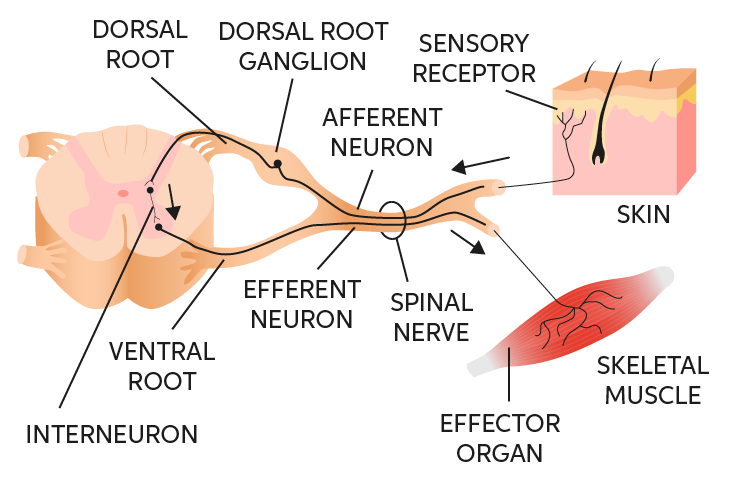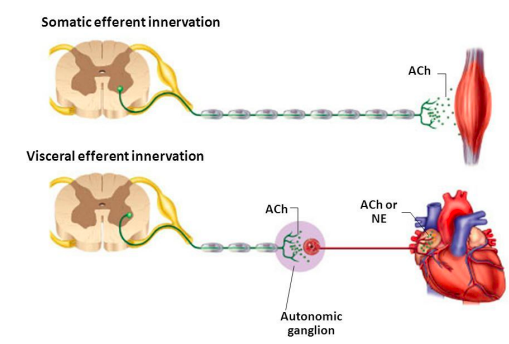
Nervous System Overview
Nervous System consists of:
Central Nervous System (CNS)
Brain
Spinal cord
Peripheral Nervous System (PNS)
Cranial nerves
Spinal nerves
Central Nervous System (CNS)
Brain: white matter surrounded by grey matter.
3 main parts of the Brain :
cerebrum
brainstem
cerebellum
White matter: mainly nerve fibres with their myelin sheaths
Grey matter: mainly nerve cell bodies and branching dendrites
Spinal cord: gray matter surrounded by white matter.

Peripheral Nervous System (PNS)
Somatic Nervous System
skeletal muscle
Autonomic Nervous System
glands, smooth muscles, cardiac muscles
Parasympathetic Nervous System: (discrete activation)
Sympathetic Nervous System: (diffuse activation)
12 pairs of cranial nerves:
olfactory (CN I)
optic (CN II)
oculomotor (CN III)
trochlear (CN IV)
trigeminal (CN V)
abducent (or abducens; CN VI)
facial (CN VII)
vestibulocochlear (CN VIII)
glossopharyngeal (CN IX)
vagus (CN X)
accessory (CN XI)
hypoglossal (CN XII)
31 pairs of spinal nerves:
8 cervical nerve pairs (C1-C8)
12 thoracic nerve pairs (T1-T12)
5 lumbar nerve pairs (L1-L5)
5 sacral (S1-S5)
1 coccygeal nerve pair
Types of Neurons:
Afferent (sensory neurons): nerve fibers responsible for bringing sensory information from different parts of the body to the CNS.
cell bodies are located just outside of the spinal cord in the dorsal root ganglion
Interneurons: central nodes of neural circuits, enabling communication between sensory or motor neurons and the CNS.
Efferent nerves: nerves that carry nerve impulses away from the CNS.
cell bodies located in the ventral horn of the spinal cord

Somatic vs Autonomic Nervous System

Somatic Nervous System | Autonomic Nervous System |
|---|---|
voluntary | involuntary |
innervate skeletal muscles | innervate smooth muscles |
one neuron between CNS and the target organ | two neurons between CNS and the target organ |
efferent arise from ventral horn cells | efferent arise from lateral horn cells |
chemical transmitter: acetylcholine | either: acetylcholine or norepinephrine |
Nervous System Overview
Nervous System consists of:
Central Nervous System (CNS)
Brain
Spinal cord
Peripheral Nervous System (PNS)
Cranial nerves
Spinal nerves
Central Nervous System (CNS)
Brain: white matter surrounded by grey matter.
3 main parts of the Brain :
cerebrum
brainstem
cerebellum
White matter: mainly nerve fibres with their myelin sheaths
Grey matter: mainly nerve cell bodies and branching dendrites
Spinal cord: gray matter surrounded by white matter.

Peripheral Nervous System (PNS)
Somatic Nervous System
skeletal muscle
Autonomic Nervous System
glands, smooth muscles, cardiac muscles
Parasympathetic Nervous System: (discrete activation)
Sympathetic Nervous System: (diffuse activation)
12 pairs of cranial nerves:
olfactory (CN I)
optic (CN II)
oculomotor (CN III)
trochlear (CN IV)
trigeminal (CN V)
abducent (or abducens; CN VI)
facial (CN VII)
vestibulocochlear (CN VIII)
glossopharyngeal (CN IX)
vagus (CN X)
accessory (CN XI)
hypoglossal (CN XII)
31 pairs of spinal nerves:
8 cervical nerve pairs (C1-C8)
12 thoracic nerve pairs (T1-T12)
5 lumbar nerve pairs (L1-L5)
5 sacral (S1-S5)
1 coccygeal nerve pair
Types of Neurons:
Afferent (sensory neurons): nerve fibers responsible for bringing sensory information from different parts of the body to the CNS.
cell bodies are located just outside of the spinal cord in the dorsal root ganglion
Interneurons: central nodes of neural circuits, enabling communication between sensory or motor neurons and the CNS.
Efferent nerves: nerves that carry nerve impulses away from the CNS.
cell bodies located in the ventral horn of the spinal cord

Somatic vs Autonomic Nervous System

Somatic Nervous System | Autonomic Nervous System |
|---|---|
voluntary | involuntary |
innervate skeletal muscles | innervate smooth muscles |
one neuron between CNS and the target organ | two neurons between CNS and the target organ |
efferent arise from ventral horn cells | efferent arise from lateral horn cells |
chemical transmitter: acetylcholine | either: acetylcholine or norepinephrine |
 Knowt
Knowt
